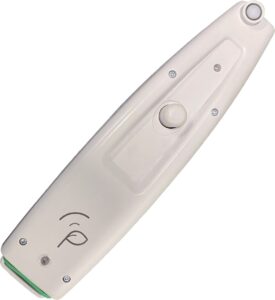MultispeQ spots canola with photosynthetic power
Crop measuring technology out of Michigan State University (MSU) presents an opportunity to improve canola cultivars for Canada.
The easy-to-use MultispeQ measures up to 28 different parameters, many of which have to do with photosynthesis. University of Alberta plant scientist Linda Gorim uses the tool in a project that aims to boost canola yields by identifying lines with the greatest photosynthetic capacity.
“We wanted people to think about making their measurements in a different way,” says David Kramer, a MSU photosynthesis and bioenergetics researcher. To really understand how plants work, numerous measurements need to be taken and under different conditions, he says. But expensive and time-consuming instruments tend to make that prohibitive.
MultispeQ, an instrument born in Kramer’s lab, changes that. The handheld device, which comes for US$99, is clipped to a plant and, in
20 seconds or less, transmits data to your cell phone. The tool measures up to 28 different parameters, many of which have to do with photosynthesis.
Through apps on mobile (Android) or desktop (PC or Mac), MultispeQ connects to the open data platform PhotosynQ where data can be saved, managed, analyzed and shared. Users can also access data stored on PhotosynQ from over 6,600 users in 28 countries working on almost 10,000 different projects, Kramer says.
This data gathering has numerous applications, including predicting yield, when disease or nutrient limitations will be present, and breeding new varieties of crops that are more resilient to environmental changes and fluctuations, he says.
With PhotosynQ being open source, the platform is both a social impact venture and a commercial product, Kramer says. “We want it to bring the kind of scientific tools that more groups of people need to improve crops around the world, or make them more accessible.” Thanks to feedback from global users, new developments are on the way. One is to measure water use efficiency in plants, which includes tiny sensors that can be hooked onto plants for days or the entire growing season.

Selecting for canola with greater photosynthesis
University of Alberta plant scientist Linda Gorim is using the technology in a project that aims to boost canola yields by identifying lines with the greatest photosynthetic capacity.
She chose the MultispeQ due to its comparatively low cost, as well as its size and ease of use. Previous challenges in measuring photosynthesis out in the field are overcome by MultispeQ’s short recording window.
“Now, it’s click and go. And we can cover more area in the same day more easily,” Gorim says.
From her office, she can watch while field measurements her students take come across her screen.
Gorim first used a previous version of the MultispeQ at the University of Saskatchewan in order to measure photosynthetic differences in lentil genotypes grown under drought stress. She has since used the device to disprove a commercial product’s claim that it could increase photosynthesis.





